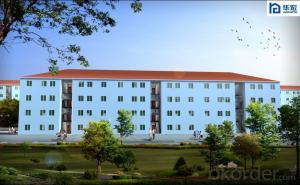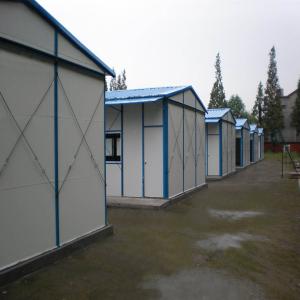New design cement house
- Loading Port:
- China Main Port
- Payment Terms:
- TT OR LC
- Min Order Qty:
- -
- Supply Capability:
- -
OKorder Service Pledge
OKorder Financial Service
You Might Also Like
More questions:
1, What's your Payment term:
30% deposit by TT, 70% balance before loading container by TT; 100% LC at sight(total payment over 100,000USD);
2, How about Shipping:
We use 20 feet container and 40HQ container to ship the goods; Usually one 20 feet container can load about 50-60 square meters' house, 40HQ container can load about 120-140 square meters's house.
3, How to become your agent in our country:
First, you can make a report about your market, include the the rules and laws of prefab house, popular house models, target price, and potential sales quantity.
Second, you must place a trial order to act as the display.
Third, after finishing the sample house and getting the local people's feedback, we will give you the agent right in one area with limited time.
Fourth, Please note that we already have agent in Mumbai City India; Marshall Islands, Trinidad and Tobago.
4, Can you help me to purchase other things like furniture or appliance:
Because the customs law, our company can only export prefab house, so we just can purchase very little matched kitchen and bathroom facilities for you in consideration of customs clearance.
5, Can you send workers to help me build house.
Considering the labor cost, safety and visa issues, we suggest to send one or two engineers to guide and train your staffs. You must provide air tickets, hotel, and meal, and 100USD per day for engineer salary.
- Q:Can container houses be designed to have a minimalist interior?
- Yes, container houses can definitely be designed to have a minimalist interior. The concept of minimalism emphasizes simplicity, clean lines, and a clutter-free environment, which can be easily achieved in a container house. With its compact and modular design, a container house provides a perfect canvas for a minimalist aesthetic. To create a minimalist interior in a container house, one can start by choosing a neutral color palette, such as whites, grays, and earth tones, which can create a calm and serene atmosphere. Minimalist design also focuses on functionality and practicality, so it is important to carefully select furniture and accessories that serve a specific purpose while maintaining a clean and uncluttered look. Utilizing smart storage solutions is crucial in a container house to avoid clutter. Built-in cabinets, shelves, and hidden storage compartments can help maximize space and keep belongings out of sight. Additionally, decluttering and embracing a less-is-more mindset is essential in achieving a minimalist interior. Lighting plays a significant role in minimalist design as well. Natural light should be maximized by incorporating large windows or skylights, allowing the space to feel bright and airy. Artificial lighting should be minimal and focused on creating a warm and inviting ambiance. In conclusion, container houses can be effectively designed to have a minimalist interior. With careful consideration of color palette, furniture selection, storage solutions, and lighting, a container house can embrace the principles of minimalism and provide a tranquil and clutter-free living environment.
- Q:Can container houses be built with a traditional bedroom layout?
- Yes, container houses can be built with a traditional bedroom layout. While container houses are often associated with more minimalist and open floor plans, they can certainly be designed to accommodate traditional bedroom setups. With proper planning and creative design, containers can be modified to include separate bedrooms, complete with walls, doors, windows, and even traditional furniture like beds, wardrobes, and bedside tables. One approach to creating a traditional bedroom layout in a container house is to stack or combine multiple containers to increase the available space. By connecting containers vertically or horizontally, one can create larger rooms that can easily accommodate a bedroom layout with enough space for a bed, furniture, and closet space. Another option is to design the container house with a combination of container and traditional construction techniques. This allows for more flexibility in layout and provides the opportunity to create designated bedrooms with walls that separate them from the rest of the house. It is important to keep in mind that container houses have certain limitations in terms of size and structural integrity. However, with proper planning and professional architectural and engineering expertise, it is definitely possible to build a container house with a traditional bedroom layout that meets your needs and preferences.
- Q:Are container houses suitable for homeless shelters or transitional housing?
- Yes, container houses can be suitable for homeless shelters or transitional housing. They are cost-effective, easy to transport, and can be quickly assembled. Container houses also provide a secure and comfortable living space, offering an opportunity for individuals to transition out of homelessness into more stable housing.
- Q:Are container houses insulated against noise?
- Indeed, noise insulation can be applied to container houses. Although the metal walls of standard shipping containers do not offer substantial noise insulation, there exist diverse approaches to soundproof and insulate container houses. Several prevalent techniques entail incorporating insulation materials like foam boards, rock wool, or fiberglass between the walls of the container and an extra layer of drywall or plywood. Furthermore, sealing any gaps and employing acoustic caulk aids in reducing noise infiltration. Through the implementation of these strategies, container houses can be adequately insulated against noise, thus establishing a serene and tranquil living environment.
- Q:Can container houses be built with a traditional aesthetic?
- Yes, container houses can definitely be built with a traditional aesthetic. While the typical image of a container house is often associated with a modern or industrial design, there are various techniques and design elements that can be incorporated to achieve a more traditional look. One way to achieve a traditional aesthetic is by using materials that are commonly associated with traditional architecture, such as wood or brick cladding. By adding these materials to the exterior of the container, it can help soften the overall appearance and blend it in with more traditional surroundings. In addition to the materials used, the layout and design of the container house can also contribute to a traditional aesthetic. For example, incorporating pitched roofs, dormer windows, and porches can create a more traditional architectural style. These elements can be added to the container house design to mimic the look of a traditional home while still utilizing the structural benefits of the containers. Furthermore, the interior design and finishes can also play a significant role in achieving a traditional aesthetic. By using classic design elements, such as crown molding, wainscoting, and traditional furniture pieces, the interior of the container house can be transformed to feel more traditional and homey. Ultimately, while container houses are often associated with a modern or industrial design, with proper planning, materials, and design choices, it is absolutely possible to build a container house with a traditional aesthetic. The key is to carefully consider the materials, layout, and interior finishes to create a cohesive design that blends the uniqueness of the container structure with traditional architectural elements.
- Q:Are container houses suitable for retail or pop-up shops?
- Yes, container houses can be suitable for retail or pop-up shops. They offer portability, cost-effectiveness, and unique aesthetics, making them an attractive option for businesses looking for temporary or mobile retail spaces. Additionally, container houses can be easily customized and modified to meet specific retail needs, making them versatile and adaptable for various types of businesses.
- Q:Are container houses prone to pests and insects?
- Container houses are not inherently more prone to pests and insects than traditional houses. However, like any other type of dwelling, container houses can be susceptible to infestations if proper preventive measures are not taken. Regular maintenance, proper sealing, and implementing pest control strategies can effectively minimize the risk of pests and insects in container homes.
- Q:Can container houses be designed to be self-sufficient?
- Yes, container houses can be designed to be self-sufficient. With careful planning and the incorporation of sustainable technology, container houses can generate their own energy through solar panels or wind turbines, collect and store rainwater for daily use, and even incorporate composting toilets for waste management. Additionally, efficient insulation and ventilation systems can help regulate temperature and reduce energy consumption. By utilizing these techniques and technologies, container houses can indeed achieve self-sufficiency.
- Q:Can container houses be designed with an open floor plan?
- Yes, container houses can indeed be designed with an open floor plan. The modular nature of container construction allows for flexibility in designing the interior layout. By removing walls or utilizing large openings, container houses can achieve an open and spacious floor plan, providing a modern and airy living space.
- Q:Can container houses be used for commercial purposes?
- Yes, container houses can be used for commercial purposes. Container houses, also known as shipping container buildings, have gained popularity in recent years due to their cost-effectiveness, sustainability, and flexibility. These structures can be easily modified and customized to accommodate various commercial needs. Container houses can be transformed into retail stores, restaurants, cafes, offices, art galleries, pop-up shops, and many other types of commercial spaces. They provide a unique and eye-catching aesthetic that can attract customers and create a memorable experience. Additionally, container houses can be easily transported to different locations, allowing businesses to adapt and expand their operations as needed. Furthermore, container houses offer numerous advantages for commercial use. They are typically less expensive compared to traditional brick-and-mortar buildings, making them an attractive option for startups and small businesses with limited budgets. Container houses are also environmentally friendly, as they repurpose old shipping containers that would otherwise go to waste. In conclusion, container houses can definitely be used for commercial purposes. They offer a cost-effective, sustainable, and flexible solution for various businesses, allowing them to create unique and functional spaces that cater to their specific needs.
1. Manufacturer Overview |
|
|---|---|
| Location | |
| Year Established | |
| Annual Output Value | |
| Main Markets | |
| Company Certifications | |
2. Manufacturer Certificates |
|
|---|---|
| a) Certification Name | |
| Range | |
| Reference | |
| Validity Period | |
3. Manufacturer Capability |
|
|---|---|
| a)Trade Capacity | |
| Nearest Port | |
| Export Percentage | |
| No.of Employees in Trade Department | |
| Language Spoken: | |
| b)Factory Information | |
| Factory Size: | |
| No. of Production Lines | |
| Contract Manufacturing | |
| Product Price Range | |
Send your message to us
New design cement house
- Loading Port:
- China Main Port
- Payment Terms:
- TT OR LC
- Min Order Qty:
- -
- Supply Capability:
- -
OKorder Service Pledge
OKorder Financial Service
Similar products
New products
Hot products
Related keywords





























